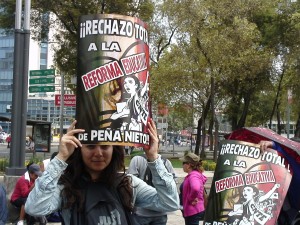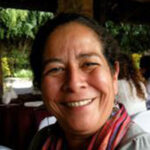Mexican teachers have hit the streets in protests against education reforms that threaten their livelihoods and the quality and accessibility of public education in the country.
Among thousands of protesters who have set up a make-shift tent city in the downtown blocks of Mexico City, women make up the less visible core of the movement. More than a million women teachers–61 percent of the education labor force–work in ill-equipped classrooms across the nation, often at wages of only several hundred dollars a month.
The rank-and-file democratic movement, known by its Spanish initials as the CNTE, has called teachers out to reject constitutional reforms that pin jobs and salary levels to the results of a standardized test and establish “operating autonomy” for schools to do their own fundraising, among other provisions. The teachers say this will destroy diversity, erode job security and lead to privatization of schools.
The media has whipped up public opinion against the teachers’ walkout, repeating ad nauseum that they are lazy and obstruct traffic. Many of the women and men here have traveled hundreds of miles from home to live under a tarp that scarcely provides protection from the torrential downpours of Mexico’s rainy season. They have to put up with little food, nowhere to wash clothes, grueling marches and the constant threat of eviction and repression.
Why do they do it?
The women of the teachers’ movement answered our questions simply and eloquently. Their responses reflect an education system in crisis—not because of incompetent teachers, but because of years of neglect and indifference and the harsh conditions of poverty that mark the lives of millions of their students throughout the country.
Women’s voices in the fight for work with dignity and quality education
“The reason to continue in his fight is because we see the injustice that exists in our state and in our country every day. And every day, as women, as mothers, as wives, we experience scarcity and injustice and we don’t think it should be this way.
“As teachers, we’re the ones who live in the communities with our students, with the mothers and fathers, and we know the scarcities they confront and it fills us with rage,” says a young teacher from the state of Oaxaca.
She explains that from her school near the food wholesale center, she sees people from the communities come in to sell their produce and girls and boys who have to work before going to school.
“Some get up at 4 or 5 in the morning to come in from their communities, bringing the fruits, vegetables or plants to sell. They go to school with no breakfast during the day and then they’re there until 8 o 9 at night when they go back to the community to sleep and start another day with the same routine,”
She’s convinced that something has to be done to break this vicious cycle but insists that the education reform is not the answer. “We know that to improve education we need structural changes and with what they approved, conditions in our communities will not get better, but definitely will get worse.
Sarvia Analí Valverde teaches pre-school in a small community in the indigenous Mixtec region of the state. She tells us that in her village, Guerrero Santa Cruz, children have to walk more than two kilometers to go to kindergarten. Many of their parents have been forced to migrate. The children get to school without any breakfast or with a knapsack with a hard tortilla spread with beans or a little salt.
Another woman from the movement who prefers not to give her name explains, “We decided to leave our family and everything behind to come to Mexico City. Even though we’re strangers to this place…many of us don’t even know how to take a subway.
“But we’re getting used to it. We came to protest against the privatizing policies of the government.” She adds, “This process has been very taxing– economically, physically and emotionally. But not only the women teachers of Oaxaca, but from other states, made the decision to come to the capital to keep up the fight.”
What should be evaluated?
An evaluation system added to the constitution lies at the heart of the protests. Valverde says it’s not true that the teachers don’t want to be evaluated.
“We want to be evaluated, but according to the social and economic context we work in, according to our reality, not standardized procedures,” she says. “We especially are not in agreement with using the evaluation not to improve education, but to punish and fire teachers.”
She explains that the teachers in her region want to improve their knowledge and skills, but their options are limited in the poor areas they work in. “We want to train more, but we’re in remote communities, with no public transport, and we only have weekends to travel to study.”
For the women on the line, it’s another case of blaming the victim.
“Some say the teachers are responsible for the backwardness of our educational system. That’s not so. The backwardness of the system is a structural problem due to, among other things, he fact that the money they should give to education is spent on other things. One good example is the last elections where huge amounts of money were spent that could have been allotted to improve education.”
For many of the protesting teachers, this is not their first mobilization. Teachers from Oaxaca remember the movement in their state in 2006, when a walk out of Section 22 of the national teachers’ union sparked a local rebellion that was violently quashed when the army was sent in.
One teacher recounts the impact of the uprising and repression. The lesson she learned was not to be afraid, but rather to be prepared.
A“I was involved in the events of 2006,” she tells us. “I recall the psychosis and the evictions, but like I told my friend, I’m not afraid. In fact, I told her we have to be ready, and always take a look around before we go to sleep.”
At least in her case, repression didn’t turn out to be a long-term deterrent. “We have no fear because we lived through this before and it didn’t paralyze us.”
Her friend adds, “When I read the newspaper every day I see reflections of 2006. This is what they did to us seven years ago—attack us, wear us out, insult us, but it just made us say, Enough!”
She recalls a history that has become a classic in the history of Mexican grassroots movements—a history forged by women.
“That’s when the women teachers decided to take matters into their own hands. We called a march and went to the media to ask for the right to give our side, but they refused–even the state TV channel that is supposed to be public.
“So thousands of women decided to take over the media. We suddenly realized we didn’t have to ask for air time, much less in spaces that are of the people, and from that moment on we stayed there. That was a very powerful action because we challenged the most basic part of this system–the communications media. And for that, they shot out the TV antennas and everything else.”
Bringing it back to the present, she says, “Maybe many people don’t understand us, but we have these histories, these experiences; all these moments of sharing small triumphs, many fears, lots of analysis of where we’re going and what we should do. Now here we are in this situation again and we look at each other and without saying anything we know why we’re here.”
 Protest and proposals
Protest and proposals
A major myth created by the media is that the teachers are protesting without offering constructive alternatives. In fact, their labor organization state by state and the teachers themselves in the workplace have been working to develop practical alternatives. Nowhere is that process as advanced as in Oaxaca.
Anabel Medina teaches at the last school of education left in the state of Oaxaca, a school for women teachers in Tamazulapam. The government has been systematically closing or reducing the budget for these colleges in preparation for privatization and to eliminate them as strongholds of rural resistance to neoliberal polices. The students and teachers have fought to hold on to what historically has been not only a place where pupils from impoverished families can gain an education degree, but also a center of defense of the economic and social rights.
Medina describes how teachers have responded to the lack of basic infrastructure and materials on the job.
“In 2000 our building collapsed and they rebuilt part of it, but just classrooms and no labs or workshops. The programs they send us are minimal, with no teaching methods so we have had to design our own methods, like the ‘emancipatory pedagogical projects’.
“Our school is rich in participation of different ethnic groups. We work in Zapotec, Nahuatl, Mixtec, Triqui, with different customs and traditions.
“We don’t want to lose this culture that we see at risk under reforms that emphasize teaching mostly English.” She describes how the college has developed new ways of teaching that don’t impose curriculum on students. “We ask them what they want to learn and start with the own experience, which we adapt to the programs. If the students know how to make rebozos or bread, we start with that knowledge and insert these concepts into our plans and programs.”
“All these advanced educational concepts that we’ve been developing are at risk under the reform,” Medina concludes.
Celiflora García Cervantes, from the community of San Esteban Atatlahuca, also trains teachers to create strategies that incorporate original languages in their teaching practice and believes the reforms will roll back their achievements. “A team of six advisers goes to the schools. We meet with technical teams and then collectively build an educational project based on the knowledge of the students, on their interests or on a particular social problem in their community and the project is conceived in both languages.”
Dealing directly with the realities of the students is central to their work. “In Oaxaca, we’re working on a plan that focuses on rescuing our own knowledge and our customs to keep us tied to our state, our Mexico. We know our own reality and that’s why we know what we need; we take the pulse of the most marginalized communities,” explains the second teacher.
She notes that many girls and boys “think only of finishing junior high and if everything goes right, migrating to the United States because they think that there they can have a better quality of life even though it’s not necessarily true. So we recognize a need to retain them here in our state, in our country, in our Mexico. We have to get keep them here, recuperate our culture, learn to love it and defend it. That’s the teacher’s job.”
For women teachers, the commitment to children is primary. “The essence of our struggle is to fight for a better future for all the boys and girls, including our own children who we had to leave behind. We miss them and it hurts terribly to be so far from them, but we know they understand because they’ve lived through all this with us. So even though every morning and every night we’re wondering how they are, and even though many of us haven’t seen our children in three weeks, we remain here because we believe that this struggle is for justice, and that it is ours and that we have to win.”
Women transforming their reality
Monica Amador, 28, teaches fourth, fifth and sixth graders in Cozoaltepec, near Puerto Escondido, in a school with only one other teacher. She makes about $320 a month. She says some of the students in her group have disabilities and she has learned to teach in sign language. When it’s coffee harvest, her students don’t attend classes because they’re out helping their families bring in the crop.
In her classroom, she has her 26 students gather around in a half-moon figure, “with my desk behind us not in front,” to break down classroom hierarchies.
Mexico’s women teachers are responsible for molding a new generation, a generation they hope will be capable to reduce the injustice and inequality of their world. They also hope to shepherd a new generation of women who will stand up and take their rightful place in the movement for change and in the better world they seek to create.
For this, being a union member is not enough.
“In the last years my understanding has broadened and now I’m here as a woman too, because I realized over time that women play an important role in the grassroots movement and we women are the ones who have been on the front lines. That’s why we think that we need to stop living in a sexist context, and that’s something else we have to fight for.
“I used to think about other people all the time, but now I also think about us–the women. I remember that before we said ‘we the teachers’ (in masculine form). Now I say “we the teachers” (in feminine form) are here too. With all our experience, with our fears, with our desires, our dreams–all that we bring to transform this reality.
“I’m here because I have this awareness that if we don’t change things for women too, in every grassroots movement, we won’t change anything in general. As members of this movement, we have the responsibility to give our vision of the world and make our participation in the social movement visible.”
Laura Carlsen is director of the Americas Program and member of JASS Mesoamerica. Alfredo Acedo is a journalist and director of communications for UNORCA.
Published by www.cipamericasprogram.org. Photos and interviews: Alfredo Acedo and the National Network of Women Human Rights Defenders in Mexico.
For more information:
Laura Carlsen and Alfredo Acedo, “Protesting Teachers Vow “This Will not End Here”, , CIP Americas Program Sept.10, 2013.http://www.cipamericas.org/archives/10623
Lynn Stephen, We are the Face of Oaxaca-Testimony and Social Movements, Duke University Press, 2013 on line at: http://es.scribd.com/doc/166027254/We-Are-the-Face-of-Oaxaca-by-Lynn-Stephen
Laura Carlsen, Oaxaca Fights Back, Nov. 14 2006 CIP Americas Program, http://www.counterpunch.org/2006/11/14/oaxaca-fights-back/
Thanks to Desinformémonos for transcriptions of the interviews by the WHRD.


























